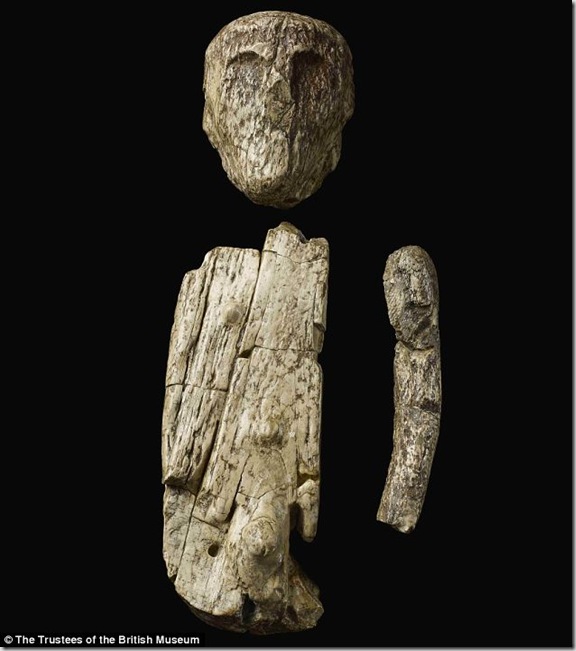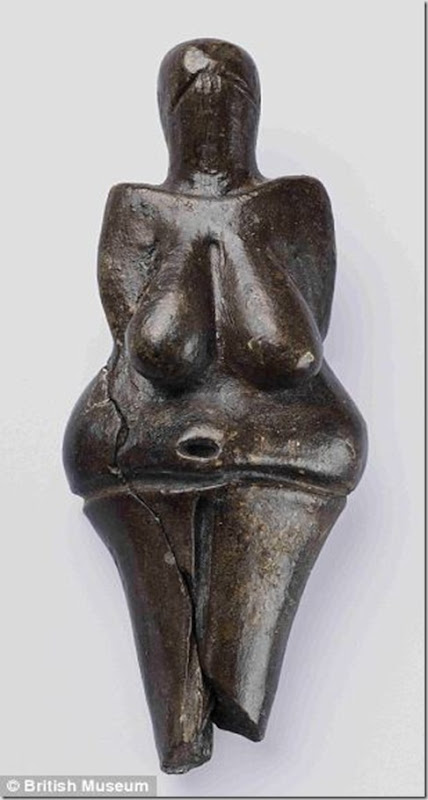An exhibition 40,000 years in the making.
7 February – 26 May 2013
at the BRITISH MUSEUM
Great Russell Street, London
These exceptional pieces will be presented alongside modern works by Henry Moore, Mondrian and Matisse, illustrating the fundamental human desire to communicate and make art as a way of understanding ourselves and our place in the world.
Ice Age art was created between 40,000 and 10,000 years ago and many of the pieces are made of mammoth ivory and reindeer antler. They show skilful, practised artists experimenting with perspectives, scale, volumes, light and movement, as well as seeking knowledge through imagination, abstraction and illusion.
One of the most beautiful pieces in the exhibition is a 23,000-year-old sculpture of an abstract figure from Lespugue, France. Picasso was fascinated with this figure and it influenced his 1930s sculptural works.
Although an astonishing amount of time divides us from these Ice Age artists, such evocative pieces show that creativity and expression have remained remarkably similar across thousands of years. Fonte
Carved from a woolly mammoth tusk 26,000 years ago, the earliest portrait of a woman ever created is set to go on display at the British Museum.
The astonishing piece of art, smaller than a thumb at just 4.8cm high, was created in the middle of the last Ice Age, in a valley in what is now Moravia in the Czech Republic, using stone tools.
Experts believe it to be the earliest ever portrait of a woman and, among with a range of other ancient works of art, it is set to go on display at a groundbreaking new exhibition at the British Museum.
 Ancient: The oldest known portrait of a woman. The 4.8cm work is sculpted from mammoth ivory and was found at Dolní Vestonice, Moravia, in the Czech Republic, it is around 26,000 years old
Ancient: The oldest known portrait of a woman. The 4.8cm work is sculpted from mammoth ivory and was found at Dolní Vestonice, Moravia, in the Czech Republic, it is around 26,000 years oldStriking examples will be displayed as works of art rather than archaeological finds, alongside major works of modern art for comparison.
'All art is the product of the remarkable structure and organisation of the modern brain,' said Jill Cook, curator of the exhibition.
'By looking at the oldest European sculptures and drawings we are looking at the deep history of how our brains began to store, transform and communicate ideas as visual images.
'The exhibition will show that we can recognise and appreciate these images.
'Even if their messages and intentions are lost to us the skill and artistry will still astonish the viewer.'
Ms Cook told the Guardian of the Moravian portrait: 'The reason we say it is a portrait is because she has absolutely individual characteristics.
'She has one beautifully engraved eye; on the other, the lid comes just over and there's just a slit.
'Perhaps she had a stroke, or a palsy, or was injured in some way.
'In any case, she had a dodgy eye. And she has a dimple on her chin: this is an image of a real living woman.'

Play time: This articulated figure made from mammoth ivory, also found in Moravia, is believed to be the earliest discovered example of a puppet or doll. Fully modern people whose brains had evolved the complex super highway of the pre-frontal cortex began to arrive in Europe out of Africa just after 50,000 years ago
 Inspirational: The Vénus de Lespugue which Picasso loved so much he kept two copies of it. Between 26,000 and 24,000 years old, it was unearthed in 1922 in the Rideaux cave of Lespugue in the foothills of the Pyrenees.
Inspirational: The Vénus de Lespugue which Picasso loved so much he kept two copies of it. Between 26,000 and 24,000 years old, it was unearthed in 1922 in the Rideaux cave of Lespugue in the foothills of the Pyrenees. Approximately 6 inches (150 mm) tall, it is carved from tusk ivory, and was damaged during excavation, causing the large missing chunk visible on the left hand side of its body. The statue also displays the earliest representation found of spun thread, as the carving shows a skirt hanging from below the hips.
Picasso was so fascinated with this ‘cubist’ piece, crafted from mammoth ivory, that he kept two copies of it.
The exhibition will show how figurative art first emerged in Europe in the midst of the Ice Age and that the people who created it were already capable not only of naturalistic expression, but also abstract representation.
 A bison sculpted 20,000 years ago from mammoth ivory found at Zaraysk, Russia: Striking examples of Ice Age era European art will are set to go on display at the British Museum in a major new exhibition. They will be shown as works of art rather than archaeological finds, alongside major works of modern art for comparison
A bison sculpted 20,000 years ago from mammoth ivory found at Zaraysk, Russia: Striking examples of Ice Age era European art will are set to go on display at the British Museum in a major new exhibition. They will be shown as works of art rather than archaeological finds, alongside major works of modern art for comparisonAt this time people lived by hunting, fishing and collecting food.
To protect themselves from the cold they wore clothes made of animal skins and furs.
Where they could they made camps under rock overhangs or in the entrances to caves but elsewhere they constructed complex settlements with tents and cabins made from animal skins supported on wooden post frames strengthened with mammoth bones.
 Practical and beautiful: This spear thrower made from reindeer antler and sculpted as a mammoth around 14,000 years ago was found in the rock shelter of Montastruc, France. The ancestors of modern Europeans in this era lived by hunting, fishing and collecting food. Experts say their art shows they had fully modern brains
Practical and beautiful: This spear thrower made from reindeer antler and sculpted as a mammoth around 14,000 years ago was found in the rock shelter of Montastruc, France. The ancestors of modern Europeans in this era lived by hunting, fishing and collecting food. Experts say their art shows they had fully modern brains Intricate: Faced with encounters with indigenous Neanderthal people and the rigours of periods of cold climate during the latter part of the last Ice Age, our ancestors began to draw and paint, as well as making models and sculpture. This tip of a mammoth tusk also found in Montastruc, France, is carved as two reindeer depicted one behind the other in this work work which is thought to be approximately 13,000 years old,
Intricate: Faced with encounters with indigenous Neanderthal people and the rigours of periods of cold climate during the latter part of the last Ice Age, our ancestors began to draw and paint, as well as making models and sculpture. This tip of a mammoth tusk also found in Montastruc, France, is carved as two reindeer depicted one behind the other in this work work which is thought to be approximately 13,000 years old,  The portraits of three reindeer and an Ibex, engraved on a rib bone found in France's Courbet Cave: The care taken over the creation of Ice Age people's art shows how it was valued for providing a way of negotiating relationships within society, with nature and with the supernatural
The portraits of three reindeer and an Ibex, engraved on a rib bone found in France's Courbet Cave: The care taken over the creation of Ice Age people's art shows how it was valued for providing a way of negotiating relationships within society, with nature and with the supernaturalTheir art shows that its creators had fully modern brains with complex synaptic links capable of storing, transmitting and analysing information through speech and visual symbols, British Museum experts said.
And the care taken over its creation shows how art was valued for providing a way of negotiating relationships within society, with nature and with the supernatural.
 Life-like: A fragment of decorated reindeer metatarsal (bone) from the Palaeolithic era, found in Madeleine, France, is engraved on the obverse surface with two reindeer, one of which is now incomplete
Life-like: A fragment of decorated reindeer metatarsal (bone) from the Palaeolithic era, found in Madeleine, France, is engraved on the obverse surface with two reindeer, one of which is now incomplete Perhaps this once hung on a cave wall: The sculpture depicts a water bird, perhaps a diver, cormorant or duck. The bird's legs are short, but lack feet, perhaps to represent the bird in flight, curators say. The back is etched with a series of distinct lines representing feathers. It is believed to be between 31,000 and 33,000 years old
Perhaps this once hung on a cave wall: The sculpture depicts a water bird, perhaps a diver, cormorant or duck. The bird's legs are short, but lack feet, perhaps to represent the bird in flight, curators say. The back is etched with a series of distinct lines representing feathers. It is believed to be between 31,000 and 33,000 years old'New stimuli such as encounters with the indigenous population of Neanderthal people and the rigors of the cold climate at this time enabled their imaginations to flourish,' the museum said in a release.
'This resulted in the production of remarkable works of art, such as the famous painted caves in as Chauvet, Lascaux and Altamira, as well as lesser known pieces made from stone, bone, antler and ivory.'
It was as the ancestors of modern Europeans struggled with the climate and strange terrain of their new home that figurative of the kind with which modern artists are associated with emerged on the continent.
The second section of the exhibition is devoted to some of the oldest figurative paintings and sculptures, including the Lespugue figure that Picasso loved.
'This figure demonstrates a visual brain capable of abstraction, the essential quality needed to acquire and manipulate knowledge which underpins our ability to analyse what we see,' Ms Cook said.
The third section of the exhibition will specifically examine how the female form has been represented - a constant theme of art made between 28,000 and 21,000 years ago.
Sculptures in ivory, stone and baked clay represent women of all ages, including detailed depictions of pregnancy, childbirth and obesity.


The sacred female form: Left, a modelled figure of a mature woman from Dolni Vestonice that is believed to be the oldest ceramic figure in the world. Right, this female figure was sculpted from steatite, also known as soap stone about 20,000 years ago. Found at Grimaldi, Italy, and is on loan from the Musée d'archéologie nationale
Throughout the exhibition works by modern artists from Picasso to Matisse will be included to establish the stylistic connections across time.
Ice Age Art: Arrival Of The Modern Mind is at the British Museum from February 7 until May 26. Admission costs £10 and tickets can be booked online at britishmuseum.org.
The museum also promises a full programme of public lectures, workshops and events to go with the show. Fonte


Nessun commento:
Posta un commento